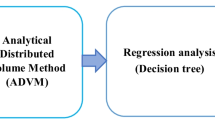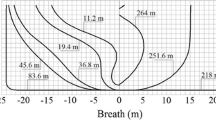Abstract
In the initial step of ship design, it is helpful to perform preliminary design and analysis on many ship configurations. One of the most important analyses is power prediction analysis. To be more efficient in powering, hydrodynamic optimization using energy saving devices is a growing field of interest in many areas of ship design. To calculate the propulsion power for a vessel, the resistance has to be determined with the highest possible accuracy. It is of practical importance to include sinkage and trim effects in the calculation of the wetted surface and so calculation of ship resistance for high-speed marine vessels. Wetted surface area varies significantly with speed, so approximate dynamic wetted area was estimated using distance laser meters, photography and 3D CAD/CAM software. Interceptors are employed in this research since they have been widely used in recent years in fast passenger ferries, high-speed motor yachts, sailing yachts, high speed fishing vessels, and military crafts. The main reasons for using interceptors are for ride and trim control, and for steering. By controlling trim during the voyage, a remarkable water resistance reduction can be achieved. The drag reduction varies by speed and by vessel type. In this study the results of preliminary experiments conducted in Istanbul Technical University’s Towing Tank are given. The experimental results revealed a noticeable reduction in total resistance over a broad speed range between Fn = 0.116 and Fn = 1.302, with benefits of 1.5–14%, and the trim reductions observed are 1.6° and 4.7°. The improvements observed are much larger at higher speeds. Also, a multiple regression analysis is utilized to make suitable predictions of the CT. The suggested model predicted the total resistance coefficient CT quite well, with an average error, compared to the model experiments, of 6.9% in chine location of the interceptor.
Access this chapter
Tax calculation will be finalised at checkout
Purchases are for personal use only
Similar content being viewed by others
References
Avci, A. G., & Barlas, B. (2015). A practical application for trim and sinkage measurements for high-speed marine vessels by using an inertial measurement unit and an arduino board. Paper presented at the 4th international conference on advanced model measurement technology for the maritime industry, Istanbul, October 2015.
Day, A. H., & Cooper, C. (2011). An experimental study of interceptors for drag reduction on high-performance sailing yachts. Ocean Engineering, 38(8–9), 983–994. https://doi.org/10.1016/j.oceaneng.2011.03.006.
De Luca, F. (2011). Experimental study on interceptor’s effectiveness. Dissertation, Universita degli studi di Napoli “Federico II”.
Ghassemi, H., Mansouri, M., & Zaferanlouei, S. (2011). Interceptor hydrodynamic analysis for handling trim control problems in the high-speed crafts. Proceedings of the Institution of Mechanical Engineers, Part C: Journal of Mechanical Engineering Science, 225, 2597–2618. https://doi.org/10.1177/0954406211406650.
ITTC. (2002). Testing and extrapolation methods high speed marine vehicles resistance test. ITTC-recommended procedures. In Proceeding of 23rd International Towing Tank Conference, Venice, 2002.
Kohansal, A. R., Ghassemi, H., & Ghaisi, M. (2010). Hydrodynamic characteristics of high speed planning hulls, including trim effects. Turkish Journal of Engineering and Environmental Sciences, 34, 155–170.
Savitsky, D. (2003). On the subject of high-speed monohulls. Paper presented at the Greek Section of the Society of Naval Architects and Marine Engineers (SNAME), Athens, October 2003.
Tsai, J. F., & Hwang, J. L. (2004). Study on the compound effects of interceptor with stern flap for two fast monohulls. Paper presented at the Oceans’04. MTTS/IEEE Techno-Ocean’04, (Vol. 2, pp. 1023–1028).
Wang, W., Zong, Z., Ni, S., Zhang, L., & Chen, L. (2012). Model tests of effects of interceptor on resistance of a semi-planing ship. Chinese Journal of Ship Research, 7(1), 18–22.
Author information
Authors and Affiliations
Corresponding author
Editor information
Editors and Affiliations
Rights and permissions
Copyright information
© 2018 Springer International Publishing AG, part of Springer Nature
About this chapter
Cite this chapter
Avci, A.G., Barlas, B., Ölçer, A.I. (2018). An Investigation of Fuel Efficiency in High Speed Vessels by Using Interceptors. In: Ölçer, A., Kitada, M., Dalaklis, D., Ballini, F. (eds) Trends and Challenges in Maritime Energy Management. WMU Studies in Maritime Affairs, vol 6. Springer, Cham. https://doi.org/10.1007/978-3-319-74576-3_10
Download citation
DOI: https://doi.org/10.1007/978-3-319-74576-3_10
Published:
Publisher Name: Springer, Cham
Print ISBN: 978-3-319-74575-6
Online ISBN: 978-3-319-74576-3
eBook Packages: Law and CriminologyLaw and Criminology (R0)




